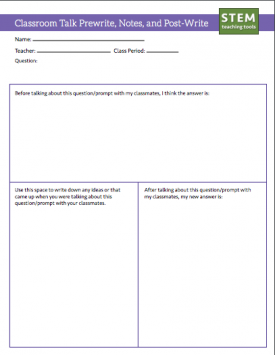Talk Resource Tools: Pre- and Post-Talk Writing Supports
 We have created two simple pre- and post-talk writing supports for students to use as part of a talk activity: Pre-Write, Notes and Post-Write and Pre-Write and Post-Write.
We have created two simple pre- and post-talk writing supports for students to use as part of a talk activity: Pre-Write, Notes and Post-Write and Pre-Write and Post-Write.
- A simple Pre-Write, Notes and Post-Write type tool can provide a familiar structure for students to engage in around classroom talk activity. Using a similar generic tool like this reduces student confusion as they become used to the tool, improves the data teachers can collect on students’ learning during instruction, and helps inform next steps of instruction. This tool is an example of what can be done to support student sensemaking, but can be easily adapted to be more specific. Having a stack of the more generic version though will allow for integration of writing during moments when you might not have planned it explicitly into your teaching.
- Not all talk activities lend themselves to writing during talk. As such we have provided a Pre-Write and Post-Write only tool also.
Things to Consider:
- It is also important to emphasize the role of drawing in student sensemaking. As we engage our students in the scientific practices of modeling or engineering, we should expect students to engage in scientific drawing practices, which include clear labels indicating thinking. Having drawing as a part of all student writing and talk activities will help foster these practices. Examples of integrating drawing include:
- Ask specifically for drawings during writing prompts as a step in making thinking clear. This is particularly important when asking students to engage in modeling practices.
- Shared construction of models on whiteboard spaces.
- Iterative versions of models or thinking through drawing in science notebooks.
- Pre-writing before talk is important for students to take a personal moment to get their own thinking in order. This type of writing supports all students, but is particularly helpful for those whose dominant language is not the language of instruction.
- Writing during talk can help students hang onto important ideas they have or hear during classroom talk. It might be helpful to have moments planned into your talk activities to pause and note take so students have a minute to collect their thinking. Examples of this could include:
- Have students capture their conversations on post-its. Then they could collect and cluster these comments into themes and display student thinking in the classroom as part of their collective sensemaking.
- Have students use science notebooks to journal their thinking as it unfolds. This journaling is for the student and thus can be done in their native language, in drawings, or in any way that provides sensemaking for the student.
- Have pairs or groups of students work on a white board. Different students can use different colored markers to hold them accountable for their contributions to the shared thinking space.
- Post-writing after talk allows students to synthesize their learning and offers teachers an opportunity to collect assessment data to inform instruction (formative).
